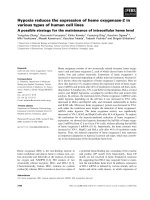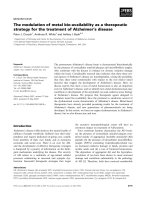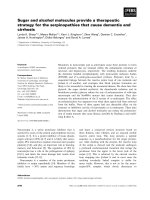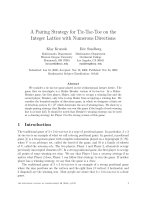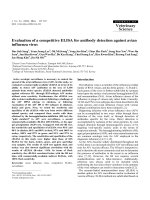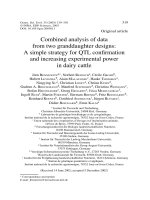Building a competitive strategy for datacraft Vietnam until 2015
Bạn đang xem bản rút gọn của tài liệu. Xem và tải ngay bản đầy đủ của tài liệu tại đây (1.01 MB, 107 trang )
TRƯỜNG ĐẠI HỌC MỞ TP.HCM
HO CHI MINH CITY OPEN UNIVERSITY
UNIVERSITÉ LIBRE DE BRUXELLES
SOLWAYS BRUSSELS SCHOOL
MBAVB3
LÊ PHONG DINH
BUILDING A COMPETITIVE
STRATEGY FOR DATACRAFT VIETNAM
UNTIL 2015
MASTER PROJECT
MASTER OF BUSINESS ADMINISTRATION
Ho Chi Minh City
(2010)
1
COMMITMENT
I hereby, Le Phong Dinh, committed my honesty for my thesis preparation and the content was
written by myself with information retrieved and obtained from reliable sources. The
information was re-produced from publication information and clearly indicated with no
plagiarism violation.
HoChiMinh City, December 2010
Le Phong Dinh
i
ACKNOWLEDGMENT
I would like to express my since thanks to all professors of the program. My deepest
gratefulness goes to professors of Solway Brussels School – University of Brussels for the
profound knowledge I have achieved during the courses and great time for discussion in case
studies.
I am also thankful to Dr. Tran Anh Tuan, Co-director of Vietnam-Belgium program for
organizing the program. My thanks are also to Mr. Serge Bywaski, the helpful co-ordinator,
who has been with us throughout the MBAVB3 course, giving help when needed and acting
enthusiastically as a bridge connection between the class and Solway professors.
I would like to express my sincere thanks to Mr. Lim Puay Koon, ASEAN Managing Director of
Datacraft Asia, for his advices for my thesis. I also would like to extend my gratitude to
colleagues, Mr. Francis Lee – Head of Solution of Datacraft Asia, executive managers of
technology vendors and managers of different companies who have spent time answering the
questionnaires that help to drive the market direction.
I would like to thanks Dr. Nguyen Dinh Tho, my tutor, for helping me to complete the thesis.
Last but not least, I also would like to express my sincere thanks to my wife for her support
during the past two years of my study.
Ho Chi Minh City, December 2010
LE PHONG DINH
ii
EXECUTIVE SUMMARY
Datacraft Vietnam is the subsidiary of Dimension Data, one of the leading system integrators in
the world. In Vietnam, Datacraft has been operated for many years and competed well with
many local companies. Given the fact that there are big opportunities as Vietnam is growing fast
and more investment in the telecommunications industry is expected, it is necessary for
Datacraft to maintain competitive. The thesis therefore goes deeply into analyzing the internal
and external environment of the company to find the fittest strategy for the company.
The thesis firstly conducts an external audit of the company environment to figure out
opportunities and threats. Following the external audit, an internal audit is done to illustrate the
strengths and weaknesses. Putting altogether, the Quantitative Strategic Planning Matrix is built
up to choose the best suitable strategies among three generic strategic, cost leadership,
differentiation and focus. To make the study more realistic and objective, two surveys and one
direct interview are conducted. The result of the surveys and information collected from direct
interview are consolidated into the Quantitative Strategic Planning Matrix.
Based on main findings from the Quantitative Strategic Planning Matrix, differentiation strategy
was chosen. Some recommendations have then been suggested to build up differentiation
strategy for Datacraft Vietnam.
iii
TABLE OF CONTENTS
COMMITMENT ....................................................................................................................... i
ACKNOWLEDGMENT ......................................................................................................... ii
EXECUTIVE SUMMARY .................................................................................................... iii
TABLE OF CONTENTS........................................................................................................ iv
LIST OF ABBREVIATIONS ................................................................................................ vii
LIST OF FIGURES .............................................................................................................. viii
LIST OF TABLES .................................................................................................................. ix
INTRODUCTION OF THE STUDY ...................................................................................... x
Chapter 1 .................................................................................................................................. 1
LITERATURE REVIEW ........................................................................................................ 1
1.1
Definition of competitive advantage............................................................................. 1
1.2
Porter’s generic competitive strategy ........................................................................... 1
1.2.1 Cost leadership strategy ............................................................................................ 2
1.2.2 Differentiation strategy ............................................................................................. 2
1.2.3 Focus strategy............................................................................................................ 3
1.2.4 Summary of generic strategies and its requirements................................................. 4
1.3
Strategy formulation process ........................................................................................ 5
1.3.1 Mission and goals ..................................................................................................... 5
1.3.2 External analysis ...................................................................................................... 5
1.3.2.1 Macro environment analysis ................................................................................ 6
1.3.2.2 Micro environment analysis................................................................................. 6
1.3.3 Internal environment analysis ................................................................................. 10
1.3.4 Strategy formulation and strategic choice ............................................................... 11
1.3.5 Strategy implementation ......................................................................................... 12
Chapter 2 ................................................................................................................................ 14
ANALYSIS OF DATACRAFT VIETNAM’S EXTERNAL ENVIRONMENT ................. 14
2.1.
Macro environment analysis ....................................................................................... 14
2.1.1 Political environment .............................................................................................. 14
2.1.2 Economics environment .......................................................................................... 15
2.1.3 Social environment.................................................................................................. 16
2.1.4 Technological environment ..................................................................................... 17
iv
2.2
Microenvironment analysis......................................................................................... 18
2.2.1 Industry and market overview ................................................................................. 18
2.2.2 Industry competitiveness and competitors analysis ................................................ 22
2.2.2.1
2.2.2.2
Substitute products ....................................................................................... 23
2.2.2.3
Bargaining power of buyers ......................................................................... 23
2.2.2.4
Bargaining power of suppliers and suppliers analysis ................................. 24
2.2.2.5
2.3.
Barriers of entry ........................................................................................... 22
Competitors Analysis ................................................................................... 25
Summary of company’s opportunities and threats .................................................... 28
2.3.1 Opportunities ........................................................................................................... 28
2.3.2 Threats ..................................................................................................................... 28
2.4
External Factor Evaluation Matrix ............................................................................. 29
Chapter 3 ................................................................................................................................ 32
ANALYSIS OF DATACRAFT VIETNAM’S INTERNAL ENVIRONMENT .................. 32
3.1
Company’s profile ...................................................................................................... 32
3.1.1 Introduction of Datacraft Asia ................................................................................ 32
3.1.2 Introduction of Datacraft Vietnam ............................................................................ 32
3.2.
Organizational structure .............................................................................................. 33
3.2.1. Organization chart ................................................................................................... 33
3.2.2 Management ............................................................................................................ 34
3.2.3 Human resources ..................................................................................................... 35
3.3
Business operation ...................................................................................................... 35
3.3.1 Company vision and goals ...................................................................................... 35
3.3.2 Market segmentation ............................................................................................... 36
3.3.3 Major Suppliers ....................................................................................................... 38
3.3.4 Products and services .............................................................................................. 38
3.3.5 Operation - Sales Team ........................................................................................... 41
3.3.6 Pricing ..................................................................................................................... 43
3.4
Financial analysis ........................................................................................................ 44
3.5
Capabilities ................................................................................................................. 47
3.6
Summary of Datacraft’s strength and weakness ......................................................... 48
3.6.1 Strengths .................................................................................................................. 48
3.6.2 Weaknesses ............................................................................................................. 48
v
3.6.3 The Internal Factor Evaluation (IFE) Matrix .......................................................... 49
3.6.4 Competitive Profile Matrix (CPM) ......................................................................... 51
Chapter 4 ................................................................................................................................ 53
DEVELOPING COMPETITIVE STRATEGIES FOR DATACRAFT VIETNAM ............ 53
4.1
SWOT analysis ........................................................................................................... 53
4.2
SWOT strategies ......................................................................................................... 55
4.3
Strategy formulation ................................................................................................... 56
4.3.1 Mission and vision for the company till 2015 ......................................................... 56
4.3.2 Developing competitive strategies for Datacraft Vietnam ...................................... 56
4.3.2.1
Cost leadership strategy ............................................................................... 56
4.3.2.2
Differentiation strategy ................................................................................ 58
4.3.2.3
Focus strategy............................................................................................... 59
4.4
Strategy evaluation – Quantitative Strategic Planning Matrix ................................... 59
4.5
Strategy implementation ............................................................................................. 63
CONCLUSIONS AND RECOMMENDATIONS ................................................................ 66
REFERENCES ......................................................................................................................... i
APPENDIX 1 CUSTOMER SURVEY .................................................................................. iii
APPENDIX 2 RESULTS OF CUSTOMERS’ SURVEY ...................................................... ix
APPENDIX 3 EMPLOYEE SURVEY ................................................................................. xv
APPENDIX 4 RESPONSES FROM DATACRAFT’S SALES TEAM ............................. xvii
APPENDIX 5 DIRECT EXECUTIVE INTERVIEW........................................................... xx
APPENDIX 6 KPI TEMPLATE FOR CLIENT MANAGERS .......................................... xxii
APPENDIX 7 KPI SETTING TEMPLATE FOR SALES MANAGERS ......................... xxiv
vi
LIST OF ABBREVIATIONS
3G
3GPP
4G
CDMA
CPI
DPI
FDI
FSI
GPRS
GSM
ITU
KPI
LAN
LTE
MNC
MPI
MPT
PC
QSPM
SI
VNNIC
VNPT
VPN
WAN
Wi-Max
WTO
Third-generation
The 3rd Generation Partnership Project
Fourth-generation
Code division multiple access
Consumer Price Index
Department of Planning and Investment
Foreign Direct Investment
Finance, Securities and Insurance
General packet radio service
Global System for Mobile Communications
International Telecommunications Union
Key Performance Index
Local Area Network
Long-term Evolution
Multi-National Companies
Ministry of Planning and Investment
Ministry of Post and Telecommunications
Personal Computer
Quantitative Strategic Planning Matrix
System Integrator
Vietnam Internet Network Information Center
Vietnam Post and Telecommunications
Virtual Private network
Wide Area Network
Worldwide Interoperability for Microwave Access
World Trade Organization
vii
LIST OF FIGURES
Figure 2.1
Revenue of the telecommunications industry
19
Figure 2.2
Revenue structure of the telecommunications industry 2006-2009
20
Figure 2.3
Suppliers’ market share
25
Figure 2.4
System Integrators’market share
27
Figure 3.1
Organization chart of Datacraft Vietnam
34
Figure 3.2
Datacraft Vietnam’s revenue by customers’ segmentation
37
Figure 3.3
Salesforces screenshot
43
Figure 3.4
Datacraft Vietnam’s Growth rate 2005 - 2010
45
Figure 3.5
Revenue structure of Datacraft Vietnam
46
viii
LIST OF TABLES
Table 1.1
Generic competitive strategies and required competencies
04
Table 1.2
Generic strategies and the five forces
10
Table 1.3
The Quantitative Strategic Planning Matrix (QSPM)
12
Table 2.1
Summary of Vietnam’s key economic indicators
15
Table 2.2
External Factor Evaluation (EFE) Matrix of Datacraft Vietnam
29
Table 3.1
Benchmark Datacraft’s products and services with key competitors
40
Table 3.2
Datacraft Financial Performance 2005 – 2010
44
Table 3.3
Internal Factor Evaluation (IFE) Matrix of Datacraft Vietnam
49
Table 3.4
Competitive Profile Matrix
52
Table 4.1
Benchmark key requirements of cost leadership strategy and Datacraft’s
resources and capabilities
Table 4.2
57
Benchmark key requirements of differentiation strategy and Datacraft’s
resources and capabilities
58
Table 4.3
Quantitative Strategic Planning Matrix (QSPM) of Datacraft Vietnam
60
Table 4.4
Summary of strategy evaluation
63
ix
INTRODUCTION OF THE STUDY
I.
Rationale of the study
Profitability is essential to all business. In order to be profitable and maintain reasonable growth
rate year on year, Datacraft must be competitive by offering services and products that satisfy
the changing clients’ demand. Datacraft’s main competitive advantage lies in its capability to
provide to the clientele business solutions that are based on client’s business domain needs.
Client’s assimilation of technology can help with the automation of certain processes, but this
will need to be tempered based on the location, business-climate and geography where the
client’s business will reside.
The Vietnamese government has expressed strong support for the growth and development of
the telecommunications industry. Given the potential growth of the industry in the next few
years, it is time for Datacraft to look back into its business environment, evaluate its strengths
and weaknesses so that Datacraft can keep track of the new trends and be competitive. The
research analyses Datacraft Vietnam’s business and how they can develop a competitive
strategy for its business, as a major system integrator in IT and telecommunications industry in
Vietnam market.
II.
Problem statement
Datacraft is one of the largest corporations in the world, ranking number three after IBM and HP
in systems integration. Datacraft is the only independent system integrator. Datacraft Vietnam
was established in 1996. After nearly 15 years of operations, Datacraft Vietnam is now facing
harsher competition from local and other foreign companies, such as FPT, DTS, HPT, Sao Bac
Dau, CT-IN, CMC, 3D Networks…Alcatel-Lucent, Ericsson, Huawei.
Though known worldwide as a multinational system integrator supported by competent and
skillful employees, Datacraft Vietnam still does not enjoy a suitable role in the Vietnamese
market in comparison with other players.
Within Datacraft Group, Datacraft Vietnam
contributes not much to the bottom line and the group’s growth.
The thesis aims at building a differentiation competitive strategy for Datacraft Vietnam based
on its key competencies and applying it in Vietnam market. The thesis will go first into
x
analyzing the macro environment in which Datacraft is operating to find out the threats and
opportunities. Then a deeper analysis via Michael Porter’s five forces will give a closer view of
the company’s industry and its performance. An internal audit is also conducted to show out the
company’s key strengths and weaknesses. All findings are then summarized in the SWOT
analysis of the company. Based on main findings, the research develops three generic strategies
for the company. An overall evaluation via the Quantitative Strategic Planning Matrix (QSPM)
is conducted to choose the most suitable competitive strategy.
III.
Research methodology
a) Objectives
•
Overall analysis of the Vietnamese IT and Telecommunications industry.
•
Examine Datacraft’s current business strategy
•
Overview of the SI market in Vietnam IT and Telecommunications industry.
Competitors’ perceived key strengths and weakness.
•
Analysis Datacraft-Vietnam’s performance in IT and Telecommunications industry,
with reference to the competition
•
Propose suitable competitive strategies for Datacraft
b) Research questions
The research questions are as following:
•
What is the addressable SI market for IT and Telecommunications?
•
What is the status quo of the competitive environment of Datacraft Vietnam?
•
How can we evaluate the SWOT of Datacraft Vietnam?
•
What is the key value of Datacraft in the client’s perception? What is the key value of
the competition? How can Datacraft change this perception?
•
What kind of competitive strategy should Datacraft develop to grow its business in
Vietnam and why?
xi
c) Data collection method
Secondary data on telecommunications industry, Datacraft’s competitors, their capability, their
operation is gathered from Business and Industry journals, Internet web sites, Vietnam
statistical year book, sales review reports and other sources. This information gives board view
about the external environment of the company. Primary data is collected mostly through
in-depth interview with company’s executive managers, key sales person at regional level.
Information about company’s business and operation is gathered from company’s annual
reports, company’s brochure and other relevant documents. A customer survey is conducted to
identify customer requirements and their potential needs. The questionnaire of customer survey
was distributed to 50 IT managers who are existing clients of Datacraft Vietnam. The survey
also aims at finding the current position of Datacraft and identifying key competitors. In
addition, an employee survey is done to get more thorough understanding of the company’s
personnel resources and sustainability. Lastly, an executive survey is conducted from
technology vendors to understand how they are viewing Vietnam market and to utilize their
technology strengths to grow their business in Vietnam. This also helps to evaluate how
Datacraft can achieve a winning business formula with these technology vendors.
The data collected is consolidated in the company a whole scenario, which will be to suggest
alternative and action plan for the company.
d) Conceptual framework of the study
The analysis of current performance of industry and company is based on the process of
strategic management, which is used to implement SWOT analysis for the company. First of all,
the company’s missions and goals are examined. Then external and internal environments are
analyzed to identify strategic situation that company is facing. Strategies are developed for the
company and evaluated to choose the most suitable one for recommendation.
xii
The below graph illustrates the framework of the research study.
Mission and Goals
External Analysis
SWOT analysis
Strategic Choice
Internal Analysis
Alternative strategies
Strategy evaluation
Recommended strategy
Recommendation
IV.
Scope and limitation of the study
The research focuses on analyzing the company’s current environment. Based on the results
from analyzing the company’s internal and external environment, the research develops a
competitive strategy in the next five years for the company. One of the key limitations of the
research is that strategy evaluation is subjective.
xiii
V.
Structure of the study
Besides the introductory chapter and conclusion chapter the study is divided into four main
chapters as following:
Chapter 1: Literature review
Literature on competitive advantage and competitive strategy as well as the strategic
management process are reviewed as the basis for analysis in following chapters.
Key objective of this chapter is to set up the theoretical framework for following chapters.
Chapter 2: Analysis of Datacraft Vietnam’s external environment
External factors including political, economic, social and technological factors are analyzed.
Customer analysis and industry analysis including competitor analysis is discussed extensively
in this section as well.
Based on the theoretical framework in chapter one, chapter 2 goes deeply into analyzing the
company’s macro and micro environments.
Key objectives of this chapter are to identify the opportunities and threats of the company.
Chapter 3: Analysis of Datacraft Vietnam’s internal environment
Company organization, business performance, operation, sales performance, and other internal
related activities are analyzed to identify strength and weakness.
Chapter 4: Developing competitive strategy for Datacraft Vietnam
Three competitive strategies are developed including cost leadership strategy, differentiation
strategy, and focus strategy and evaluated. Based on the company’s SWOT analysis, the
Quantitative strategic Planning Matrix (QSPM) is created to choose the most suitable strategy.
xiv
Chapter 1
LITERATURE REVIEW
1.1
Definition of competitive advantage
According to Michael Porter, competitive advantage is defined as follows: “When two or more
firms compete within the same market, one firm possesses a competitive advantage over its rival
when it earns or has the potential to earn a persistently higher rate of profit.”1
Competitive advantages give the firm an edge over its competitors and an ability to generate
greater value for the firms. Competitive advantage can lead to the firm’s success. Simply
obtaining competitive advantage is inadequate since competitors will soon adapt and imitate
that advantage. A firm instead must strive to achieve sustainable competitive advantage by
continually adapting to changes in external trends and events and internal capabilities
competencies and resources and by effectively formulating, implementing and evaluating
strategies that capitalize upon those factors.
1.2
Porter’s generic competitive strategy
Different sources of competitive advantage leads to different competitive strategy. According to
Michael Porter, there are strategies that allow firms to gain competitive advantage from three
different bases: cost, differentiation and focus. These strategies are called generic strategies.
Cost leadership emphasizes producing standardized products at a very low per unit cost for
consumers who are price sensitive. Meanwhile, differentiation strategy aims at producing
products and services considered unique industry-wide and directed at consumers who are
relatively price sensitive. The generic strategy of focus rests on the choice of a narrow
competitive scope within an industry. The focuser selects a segment or group of segments in the
industry and tailors its strategy to serving them to the exclusion of others.
1
Robert M. Grant, “Contemporary Strategy Analysis”, Blackwell Publishing, 2005, p.225
1
1.2.1
Cost leadership strategy
In cost leadership, a firm sets out to become the low cost producer in its industry. The sources of
cost advantage are varied and depend on the structure of the industry. They may include the
pursuit of economies of scale, proprietary technology, preferential access to raw materials and
other factors. A low cost producer must find and exploit all sources of cost advantage. If a firm
can achieve and sustain overall cost leadership, then it will be an above average performer in its
industry, provided it can command prices at or near the industry average. There are two major
ways that a firm can gain a cost advantage:
-
Control cost drivers: A firm can gain an advantage with respect to the cost drivers of
value activities representing a significant proportion of total costs
-
Reconfigure the value chain: A firm can adopt a different and more efficient way to
design, produce, distribute, or market the product.
Firms that succeed in cost leadership often have the following internal strengths:
-
Access to the capital required to make a significant investment in production assets; this
investment represents a barrier to entry that many firms may not overcome
-
Skill in designing products for efficient manufacturing, for example, having a small
component to shorten the assembly process
-
High level of expertise in manufacturing process engineering
-
Efficient distribution channels.
1.2.2
Differentiation strategy
Following differentiation strategy, a firm seeks to be unique in its industry along some
dimensions that are widely valued by buyers. It selects one or more attributes that many buyers
in an industry perceive as important, and uniquely positions itself to meet those needs. It is
rewarded for its uniqueness with a premium price.
The means for differentiation are peculiar to each industry. Differentiation can be based on the
product itself, the delivery system by which is sold, the marketing approach and a broad range of
other factors.
Uniqueness does not lead to differentiation unless it is valuable to the buyer. A successful
2
differentiator finds ways of creating value for buyer that the price premium in excess of extra
cost. A firm creates value for a buyer that justifies a premium price (or preference at an equal
price) through two mechanisms: by lowering buyer cost and by raising buyer performance.
Firms that succeed in differentiation strategy often have the following internal strengths:
-
Access to leading scientific research
-
Highly skilled and creative product development team
-
Strong sales team with the ability to successfully communicate the perceived strengths
of the products
1.2.3
Corporate reputation for quality and innovation
Focus strategy
The generic strategy of focus rests on the choice of a narrow competitive scope within an
industry. The focuser selects a segment or group of segments in the industry and tailors its
strategy to serving them to the exclusion of others. This strategy is quite different from the
others because it rest on the choice of a narrow competitive scope within the industry. The
focuser selects a segment or group of segment in the industry and tailors its strategy to serving
them to the exclusion of others. By optimizing its strategy for the target segments, the focuser
seeks to achieve a competitive advantage in its target segments even though it does not possess
a competitive advantage overall. Firm using focus strategy often enjoys a high degree of
customer loyalty, and this entrenched loyalty discourages other firms from competing directly.
The focus strategy has two variants.
-
In cost focus a firm seeks a cost advantage in its target segment.
-
In differentiation focus, a firm seeks differentiation in its target segment.
Both variants of the focus strategy rest on differences between a focuser's target segment and
other segments in the industry. The target segments must either have buyers with unusual needs
or else the production and delivery system that best serves the target segment must differ from
that of other industry segments. Cost focus exploits differences in cost behavior in some
segments, while differentiation focus exploits the special needs of buyers in certain segments.
3
1.2.4
Summary of generic strategies and its requirements
Internally, in order to pursuit a generic strategy, firms need to evaluate its own resources and
capabilities. The below table summarize key internal requirements of each generic strategy:
Table 1.1 Generic competitive strategies and required competencies 2
Strategy
Cost Leadership
Differentiation
Focus
Commonly
Substantial capital
Strong marketing
Combination of
required
investment and access to
abilities
common skills
skills and
capital
Product engineering
directed at the
resources
Process engineering skills Creative flair
Intensive supervision of
Strong capability in
labor
basic research
Products designed for
Corporate reputation for
ease in manufacture
quality or technological
Low cost distribution
leadership
system
particular strategic
Long tradition in the
market
industry or unique
combination of skills
drawn from other
businesses
Strong cooperation
from channels
Common
Tight cost control
Strong coordination
Combination of the
Organization
Frequent, detailed control
among functions in
common
requirements
reports
R&D, product
organizational
Structure organization
development, and
requirement directed
and responsibilities
marketing
at the particular
Incentives based on
Subjective
strategic market
meeting strict quantitative measurement and
2
Adapt from Porter, Michael E., 1980. Competitive Strategy: Techniques for Analyzing Industries and
Competitors. 1998 Ed. with new introduction, NewYork, The Free Press, page 40-41.
4
targets
incentives instead of
quantitative measure
Amenities to attract
highly skilled labor,
scientists, or creative
people
1.3
Strategy formulation process
Strategy formulation process refers to the process by which managers choose a set of strategies
for company. This process can be broken down into five major steps: (1) developing company’s
mission and goals; (2) analysis of external environment to identify opportunities and threats; (3)
analysis of organization’s strength and weakness; (4) selection of strategies built on
organization’s strength and other external factors and correct its weakness in order to take
advantage of opportunities and counter threats; and (5) strategy implementation.
1.3.1
Mission and goals
The beginning point of strategic management process is to review and/or selecting new
organization’s mission and major goals. This statement will be the foundation for strategy
formulation and implementation in later steps. The mission sets out the reason why the
organization exists, whose benefit it serves and what it should do.
Major goals are the targets that an organization wants to fulfill in long or medium term. Most
profit-seeking organizations place maximization of profit near the top of their goals. Goals
should be specific and measurable within a time frame.
1.3.2
External analysis
External analysis focuses on examination of relevant external elements to organization. The
object of this analysis is to identify threats and opportunities facing organization both present
and potential. An opportunity is a trend or event that could lead to significant upward change in
sales and profit pattern- given appropriate response. A threat is a trend or event that will result in
the absence of strategic move, in a significant reduction in sales and profit figures. The essence
of building competitive is relating to the company’s environment. Company’s environment
includes macro environment and micro environment.
5
1.3.2.1 Macro environment analysis
-
Political factors. These refer to government policy such as the degree of intervention in
the economy. What goods and services does a government want to provide? To what
extent does it believe in subsidizing firms? What are its priorities in terms of business
support?
-
Economic factors. These include interest rates, taxation changes, economic growth,
inflation and exchange rates.
-
Social factors. Changes in social trends can impact on the demand for a firm's products
and the availability and willingness of individuals to work. In the United Kingdom, for
example, the population has been ageing. This has increased the costs for firms who are
committed to pension payments for their employees because their staffs are living
longer.
-
Technological factors: new technologies create new products and new processes.
Technology can reduce costs, improve quality and lead to innovation. These
developments can benefit consumers as well as the organizations providing the products.
1.3.2.2 Micro environment analysis
Normally, a micro environment analysis is done via Porter's five forces. These forces include three forces from 'horizontal' competition: threat of substitute products, the threat of established
rivals, and the threat of new entrants; and two forces from 'vertical' competition: the bargaining
power of suppliers and the bargaining power of customers. The five forces determine industry
profitability because they influence the prices, costs and required investment of firms in an
industry.
The threats of the entry of new competitors
The competition in an industry will be higher, the easier it is for other companies to enter this
industry. In such a situation, new entrants could change major determinants of the market
environment at any time. The threat of new entries will depend on the extent to which there are
barriers to entry. These are typically:
-
Economies of scale,
-
High initial investments and fixed costs, capital requirement,
6
-
Cost advantages of existing players due to experience curve effects of operation with
fully depreciated assets,
-
Brand loyalty of customers,
-
Protected intellectual property like patents, licenses etc,
-
Scarcity of important resources, e.g. qualified expert staff,
-
Access to raw materials is controlled by existing players,
-
Distribution channels are controlled by existing players,
-
Existing players have close customer relations, e.g. from long-term service contracts,
-
High switching costs for customers,
-
Legislation and government policies,
-
Access to distribution,
-
Expected retaliation by incumbents,
-
Industry profitability; the more profitable the industry the more attractive it will be to
new competitors,
The intensity of competitive rivalry
Rivalry among competing firms is usually the most powerful forces. This force describes the
intensity of competition between existing players in an industry. High competitive pressure
results in pressure on prices, margins, hence on profitability for every single company in the
industry. Competition between existing players is likely to be high when:
-
There are many players of about the same size, similar strategies;
-
There is not much differentiation between players and their products, hence there is
much price competition;
-
Low market growth rates (growth of a particular company is possible only at the expense
of a competitor);
-
Barriers for exit are high (e.g. expensive and highly specialized equipment).
7
For most industries, the intensity of competitive rivalry is the major determinant of the
competitiveness of the industry. Competitive rivalry is likely to be based on dimensions such as
price, quality, and innovation. Technological advances protect companies from competition.
Companies that are successful with introducing new technologies are able to charge higher
prices and achieve higher profits, until competitors imitate them.
The threat of substitute products or services
A threat from substitutes exists if there are alternative products with lower prices of better
performance parameters for the same purpose. They could potentially attract a significant
proportion of market volume and hence reduce the potential sales volume for existing players.
This category also relates to complementary products. Similarly to the threat of new entrants,
the threat of substitutes is determined by factors like:
-
Brand loyalty of customers,
-
Close customer relationships,
-
Switching costs for customers,
-
The relative price for performance of substitutes,
-
Current trends.
The bargaining power of customers (buyers)
The bargaining power of customers determines how much customers can impose pressure on
margins and volumes. Customers bargaining power is likely to be high when:
-
They buy large volume or there is a concentration of buyers,
-
The supplying industry comprises a large number of small operators
-
The supplying industry operates with high fixed costs,
-
The product is undifferentiated and can be replaces by substitutes,
-
Switching to an alternative product is relatively simple and is not related to high costs,
-
Customers have low margins and price sensitive,
-
Customers could produce the product themselves,
8
-
The product is not of strategic importance for the customer,
-
The customer knows about the production costs of the product
The bargaining power of customers is also described as the market of outputs: the ability of
customers to put the firm under pressure, which also affects the customer's sensitivity to price
changes.
The bargaining power of suppliers
The term 'suppliers' comprises all sources for inputs that are needed in order to provide goods or
services. Supplier bargaining power is likely to be high when:
-
The market is dominated by a few large suppliers rather than a fragmented source of
supply,
-
There are no substitutes for the particular input,
-
The suppliers customers are fragmented, so their bargaining power is low,
-
The switching costs from one supplier to another are high,
-
There is the possibility of the supplier integrating forwards in order to obtain higher
prices and margins. This threat is especially high when
-
The buying industry has a higher profitability than the supplying industry,
-
Forward integration provides economies of scale for supplier.
-
The buying industry hinders the supplying industry in their development (e.g. reluctance
to accept new releases of products),
9
The industry forces have its own attributes that can affect the firm’s decision in pursuing
competitive strategies. The following table gives an overall view of each strategy in the context
of the Porter’s five forces:
Table 1.2 Generic strategies and the five forces 3
Industry
Force
Entry
Barriers
Cost Leadership
Ability to cut price in
retaliation
deters
potential entrants
Buyer
Power
Ability to offer lower
price
to
powerful
buyers
Supplier
Power
Better insulated from
powerful suppliers
Can use low price to
Threat of defend
against
Substitutes substitutes
Rivalry
1.3.3
Better able to compete
on price
Generic Strategies
Differentiation
Customer loyalty can
discourage
potential
entrants
Large buyers have less
power to negotiate
because of few close
alternatives
Focus
Focusing develops core
competencies that can act
as an entry barriers
Large buyers have less
power
to
negotiate
because of few close
alternatives
Suppliers have power
because of low volumes,
but a differentiation
Better able to pass on focused firm is better able
supplier price increases to pass on supplier price
to customers
increases
Customers
become
attached
to
differentiating attributes Special products and core
reducing
threat
of competency
protect
substitutes
against substitutes
Rivals
cannot
meet
Brand loyalty to keep differentiation-focused
customers from rivals
customer needs
Internal environment analysis
The third step in strategic management process involves finding out firm’s strength and
weakness. Sales, sales growth and profitability are major measurements of business
performance and past strategy. The analysis covers resources, capability that is vital to build and
sustain competitive advantage. Resource and capability are distinctive competencies lying in
different functional departments like marketing, manufacturing, manager or employee’s skills
3
Adapt from Porter, Michael E., 1980. Competitive Strategy: Techniques for Analyzing Industries and
Competitors. 1998 Ed. with new introduction, NewYork, The Free Press
10

